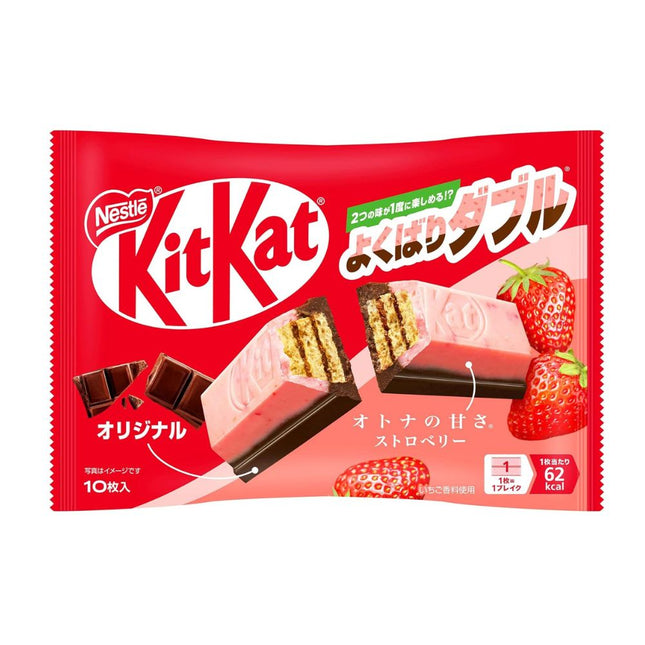Explora los snacks japoneses kawaii: Delicias adorables que te encantarán
-
- 4 Tiempo mínimo de lectura
Si hablamos de snacks japoneses kawaii , te espera una delicia divertida, adorable y deliciosa. La palabra " kawaii " significa "lindo" en japonés y es una parte fundamental de la cultura pop del país. Desde comida adorable hasta personajes y empaques kawaii , los snacks japoneses son un deleite para la vista y el paladar. ¡Adentrémonos en el mundo de los snacks japoneses kawaii y descubramos por qué son tan queridos por fans de todo el mundo!
¿Qué es kawaii y por qué es tan popular en Japón?
El concepto de kawaii en Japón va más allá de ser simplemente adorable. Refleja una estética kawaii que se encuentra en todo, desde la moda hasta la comida. Ya sean colores pastel, diseños divertidos o personajes de anime , lo kawaii en Japón abarca todo lo suave, dulce y conmovedor. A menudo encontrarás comida kawaii en panaderías, restaurantes e incluso tiendas de conveniencia, con empaques adorables y temáticas divertidas que atraen tanto a niños como a adultos.
La influencia de la cultura kawaii en los snacks japoneses
En Japón, los dulces y snacks kawaii son una parte fundamental de la vida diaria. Esta "cultura de la ternura" se ha visto influenciada por el auge del anime y el manga , los personajes kawaii y la pasión de Japón por el atractivo visual. Desde adorables personajes de manga hasta figuras icónicas como Totoro y las creaciones del Studio Ghibli , la influencia de los snacks kawaii está presente en todas partes.
Snacks japoneses kawaii que debes probar
Tanto si te gusta lo original como si simplemente te encanta la comida adorable , en Konbini Stop encontrarás una gran variedad de snacks kawaii para explorar. Aquí tienes algunos de nuestros snacks más populares que abrazan el lado adorable de la cultura japonesa:
1. Snacks de Hello Kitty de Sanrio
Una de las caras más reconocibles del estilo kawaii , Hello Kitty , se ha hecho un hueco en innumerables dulces deliciosos. Nuestra colección de snacks de Sanrio incluye gomitas, galletas y dulces de Hello Kitty que son casi demasiado adorables para comer. Estos dulces snacks reflejan a la perfección la estética kawaii y son ideales como regalo o recuerdo de fiesta.
2. Bocadillos de crema Totoro y donas Floresta
Aunque no está disponible en Konbini Stop, entre los postres kawaii más famosos de Japón se encuentran los profiteroles de Totoro y las adorables donas con forma de animal de Floresta Donuts . Estos postres están inspirados en queridos personajes de anime como Totoro de Studio Ghibli y son el ejemplo perfecto de cómo el kawaii en Japón une la comida y el arte.
Snacks Kawaii y el poder del packaging
Una de las principales razones por las que los snacks japoneses kawaii destacan es su empaque. Japón es conocido por su atención al detalle, y los personajes kawaii suelen aparecer en cajas de snacks, envoltorios de caramelos e incluso bebidas. Esto hace que los snacks japoneses no solo sean deliciosos, sino también muy coleccionables. Ya sean colores pastel, letras de gatitos o personajes de anime en la etiqueta, ¡el empaque es tan encantador como las golosinas que contiene!
La estética kawaii en los snacks japoneses
La estética kawaii en los snacks se basa en una mezcla de diseños divertidos, formas coloridas y sabores únicos. Algunos snacks presentan diseños intrincados, como flores comestibles o comida tierna con forma de animales, mientras que otros usan colores y texturas divertidas para crear una experiencia sensorial. Ya sea que te gusten los dulces kawaii o los dulces salados, hay un montón de snacks adorables para probar.
Cómo los snacks kawaii reflejan la cultura pop japonesa
En Japón, la moda kawaii y la comida van de la mano. Así como el concepto kawaii ha marcado las tendencias de moda, también ha influido en la presentación de los snacks. La palabra kawaii se ha convertido en sinónimo de algo encantador o adorable, y esto se ha extendido a la comida. Con diseños inspirados en personajes de anime y mascotas populares, los snacks kawaii aportan un toque de alegría y diversión a la vida cotidiana.
Compra snacks kawaii en Konbini Stop
En Konbini Stop , ofrecemos una amplia selección de snacks japoneses kawaii . Ya sea que busques snacks de Sanrio , golosinas de Hello Kitty o simplemente dulces kawaii para alegrarte el día, tenemos todo lo que necesitas. ¡Compra ahora y añade un toque de cultura kawaii a tu colección de snacks!















